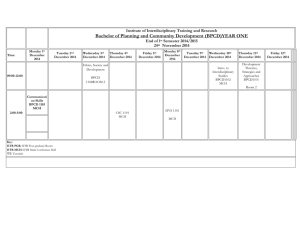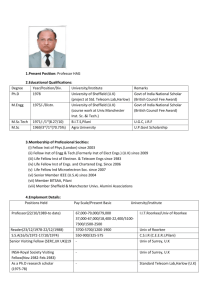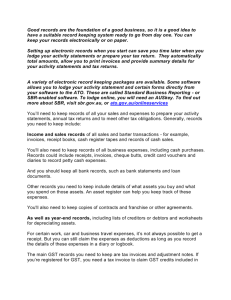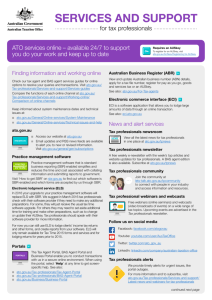ATO IITR.0001 2014 Business Implementation Guide
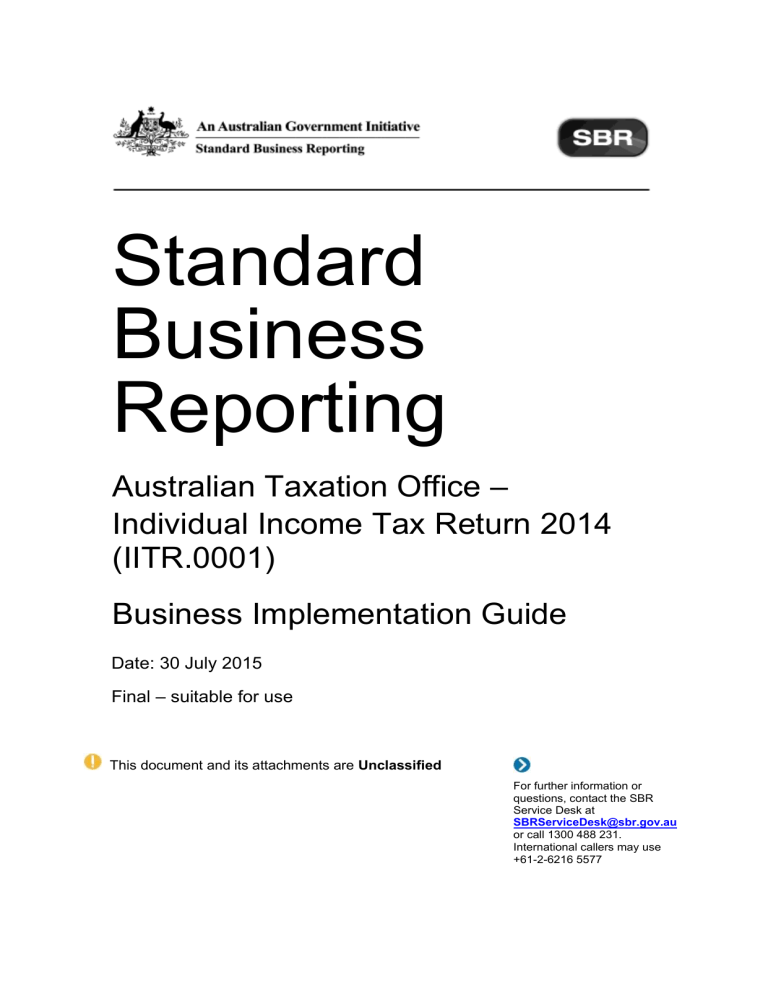
Standard
Business
Reporting
Australian Taxation Office –
Individual Income Tax Return 2014
(IITR.0001)
Business Implementation Guide
Date: 30 July 2015
Final – suitable for use
This document and its attachments are Unclassified
For further information or questions, contact the SBR
Service Desk at
SBRServiceDesk@sbr.gov.au
or call 1300 488 231.
International callers may use
+61-2-6216 5577
STANDARD BUSINESS REPORTING ATO IITR.0001 2014 BUSINESS IMPLEMENTATION GUIDE
VERSION CONTROL
Version Release date
1.0 09/07/2015
Description of changes
Changes made in these sections for final:
- Section 1.1: Clarified scope of SBR service for 2014 IITR
- Section 2.5: Updated text for clarity
- Section 2.6: Added text to specify Rental Schedule can only have one property per schedule.
- Section 2.7: Clarified SBR service interactions are for 2014 IITR
- Section 3.1: Clarified text for link between tax agent and taxpayer in
ATO systems
- Section 4.1: Added Constraint #2
- Section 6.5: Updated mandatory SBR aliases for RFC
VERSION 1.0 UNCLASSIFIED PAGE 2 OF 20
STANDARD BUSINESS REPORTING ATO IITR.0001 2014 BUSINESS IMPLEMENTATION GUIDE
ENDORSEMENT
APPROVAL
Adam O’Grady
Gary Warne
Director
Design Engagement and Issues Management
Small Business/Individual Taxpayers
Australian Taxation Office
ELS2SBR Program Manager
Tax Practitioner, Lodgment Strategy and Compliance Support
Australian Taxation Office
Copyright
© Commonwealth of Australia 2015 (see exceptions below).
This work is copyright. Use of this Information and Material is subject to the terms and conditions in the
"SBR Disclaimer and Conditions of Use" which is available at
http://www.sbr.gov.au
. You must ensure that you comply with those terms and conditions. In particular, those terms and conditions include disclaimers and limitations on the liability of the Commonwealth and an indemnity from you to the
Commonwealth and its personnel, Standard Business Reporting Agencies and their personnel.
You must include this copyright notice in all copies of this Information and Material which you create. If you modify, adapt or prepare derivative works of the Information and Material, the notice must still be included but you must add your own copyright statement to your modification, adaptation or derivative work which makes clear the nature of your modification, adaptation or derivative work and you must include an acknowledgement that the adaptation, modification or derivative work is based on
Commonwealth or SBR Agency owned Information and Material. Copyright in SBR Agency specific aspects of Standard Business Reporting Taxonomy is owned by the relevant SBR Agency.
VERSION 1.0 UNCLASSIFIED PAGE 3 OF 20
STANDARD BUSINESS REPORTING ATO IITR.0001 2014 BUSINESS IMPLEMENTATION GUIDE
TABLE OF CONTENTS
VERSION 1.0 UNCLASSIFIED PAGE 4 OF 20
STANDARD BUSINESS REPORTING
1. INTRODUCTION
ATO IITR.0001 2014 BUSINESS IMPLEMENTATION GUIDE
1.1 PURPOSE
The purpose of this document is to provide information that will assist software developers in understanding the business context surrounding Individual Income Tax Return (IITR) interactions. These interactions are performed with the Australian Taxation Office (ATO) through the Standard Business
Reporting (SBR) platform.
This document defines the interactions that are available to a tax agent to lodge an IITR, and explains any constraints and known issues with the use of the interaction, providing guidance with certain identified issues.
Specifically, this refers to the interactions with the ATO for a user, depending on their role, to:
Validate entries in an IITR or application for refund of franking credits (RFC)
Lodge an IITR including schedules where appropriate
Lodge an amendment to an IITR
Lodge an RFC
Lodge an amendment to an RFC
Lodge an RFC or IITR (original or amended) for a prior year as a SBR ebMS3 message containing the ELS tag formatted data
The IITR.Prefill
interaction is part of the IITR service but is not in the scope of this document. See the
Pre-fill IITR Business Implementation Guide for further information on the IITR.Prefill
interaction.
This document applies to the SBR service for 2014 IITRs and the SBR ELStagFormat service for the years 1998-2013.
1.2 AUDIENCE
The audience for this document is any organisation that will be implementing the ATO IITR lodgment interactions into their products. Typically this will be software application developers and business analysts.
1.3 DOCUMENT CONTEXT
The ATO IITR Business Implementation Guide forms part of the broader suite of documents used by the
ATO to describe or interpret how the technical implementation relates back to the business context and process. This document is designed to be read in conjunction with the ATO SBR documentation suite including the:
Web service/platform information
Message information e.g. ATO Message Implementation Guide, and
Test information e.g. Conformance suites
See the SBR high level document map for the relationship of this document with others in the suite.
1.4 GLOSSARY
This table only contains terms that need specific explanation for this document. Other terminology can be found in the SBR glossary .
VERSION 1.0 UNCLASSIFIED PAGE 5 OF 20
STANDARD BUSINESS REPORTING ATO IITR.0001 2014 BUSINESS IMPLEMENTATION GUIDE
Term
ATO
BMS
BSB
CGTS
DIDS ebMS3
ELS
FIA
Individual
Initiating Party
IITR
Intermediary
IT
PSS
Reporting Period
RFC
RS
SBR
TFN
WRE
Definition
Australian Taxation Office
Business Management Software
Bank State Branch number
Capital Gains Tax schedule
Dividend and Investment Deductions Schedule (DIDS) ebXML Messaging Service, version 3.0
Electronic Lodgment Service
(for full definition please see the SBR Glossary )
Financial Institution Account
A natural person (that is, a human being)
The type of user performing an SBR request. Could be an intermediary or the reporting party (e.g. Business) themselves, depending on the service.
Individual Income Tax Return
A party that facilitates a transaction between a taxpayer and the ATO
Income Tax
Payment Summary Schedule
The date range applicable for the obligation (ie IITR or RFC); usually aligning to 1
July to 30 June, however some taxpayers have a substituted accounting period with other dates.
Application for refund of franking credits
Rental Schedule
Standard Business Reporting
(for full definition please see the SBR Glossary )
Tax file number
(for full definition please see the SBR Glossary )
Work Related Expenses schedule
VERSION 1.0 UNCLASSIFIED PAGE 6 OF 20
STANDARD BUSINESS REPORTING ATO IITR.0001 2014 BUSINESS IMPLEMENTATION GUIDE
2. WHAT ARE THE IITR LODGMENT INTERACTIONS?
The IITR lodgment interactions allow tax agents using SBR-enabled software to interact electronically to validate and lodge their client ’s individual income tax obligations. This allows easier and more accurate lodgment of returns.
2.1 TAX RETURN FOR INDIVIDUALS
The information provided in a tax return allows the ATO to work out a taxpayer’s tax refund or tax debt.
Tax returns usually cover the financial year, which ends on 30 June and are due by 31 October. A registered tax agent can usually lodge later than this, but a taxpayer needs to register with them as a client before 31 October to qualify.
Most people need to lodge a tax return each year, but there are some exceptions. If an individual had tax withheld from any payment they received, they almost certainly need to lodge a tax return. For more information on whether a taxpayer needs to lodge a tax return, please see the ATO website .
2.2 SOLE TRADERS
The IITR can be used for the lodgment obligation of an individual taxpayer who is also a sole trader to report their taxable income or loss. This includes:
assessable business income less the business deductions they can claim; and
other assessable income, such as salary and wages (shown on a payment summary), dividends and rental income, less any allowable deductions against this income.
Sole traders are not able to self-lodge through SBR, and must engage the services of a registered tax agent or use one of the ATOs self-preparer options such as e-tax.
2.3 APPLICATION FOR REFUND OF FRANKING CREDITS
When an individual owns shares or non-share equity interests in a company or when an individual invests in a managed fund, they might receive dividend distributions. Dividends paid to an individual by
Australian companies and some New Zealand companies are taxed under a system known as imputation. The tax paid by the company is allocated (or imputed) to the individual as franking credits attached to the dividends the individual receives.
If the franking credits the individual receives exceed the tax an individual has to pay, they can claim this difference back as a tax refund. This is what is known as a refund of excess franking credits (RFC). If the taxpayer does not normally lodge a tax return, they may be entitled to a refund of the excess franking credits. A RFC can only be used to lodge if the client is not required to lodge a full ITR.
An RFC can also be lodged if the taxpayer has had amounts withheld from their dividends because they did not provide their tax file number. The RFC follows the same business process as an original or
amended IITR lodgment, as depicted in figure 1 of Section 2.5 below.
For more information on refunds of franking credits for individuals, please see the ATO website .
2.4 EARLY LODGMENTS
Early lodgment of the individual income tax return will not be accepted via SBR. This will be supported in a future Tax Time iteration of the service.
VERSION 1.0 UNCLASSIFIED PAGE 7 OF 20
STANDARD BUSINESS REPORTING ATO IITR.0001 2014 BUSINESS IMPLEMENTATION GUIDE
2.5 WHERE SBR FITS INTO INDIVIDUAL LODGMENT OBLIGATIONS
The IITR service provides a number of functions for lodgment of an individual taxpayer’s reporting obligations. These include the lodgment of:
The taxpayer’s Individual Income Tax Return where appropriate (including schedules)
An application for the refund of franking credits where appropriate.
Amendments to either of the above
The pre-lodge and lodge interactions are the core part of the SBR-enabled IITR business process.
These are envisaged to take place after a tax agent has checked for their client ’s outstanding lodgments, viewed their pre-fill data, and interviewed the taxpayer.
When the agent has gathered all information required (including pre-fill), the agent would then complete the return, validate it, and if required, correct any labels before lodgment.
VERSION 1.0 UNCLASSIFIED PAGE 8 OF 20
STANDARD BUSINESS REPORTING ATO IITR.0001 2014 BUSINESS IMPLEMENTATION GUIDE
Individual Taxpayer Lodgment Process
– Context of SBR IITR interactions
Individual Taxpayer Tax Agent SBR Service offering
Engages tax agent for original or amended return
Check Client
Lodgments
ITLDGSTS.list
*
Check The
Lodgment
Status
Review status of lodgments
VERSION 1.0
Retrieve client data
Interview Client
IITR.Prefill
*
Retrieve pre-fill data
Provides additional information
Completes IITR or RFC (original or amended)
YES does data need correction?
Validate
IITR.Prelodge
Validate the
IITR before lodgment
*
WARNING/SUCCESS
Corrects Error
View Success
Message
NO
– lodge IITR
ERROR
Resubmit
IITR.Lodge
Lodge the IITR
SUCCESS
Check status of lodgment
ITLDGSTS.list
*
Check The
Lodgment
Status
Receives Notice of Assessment
(and refund payment if applicable)
NO
Receives Notice of Assessment
(and refund payment if applicable)
YES
Refund to Agent?
* Optional interaction
Figure 1: SBR interactions and IITR lodgment business process
UNCLASSIFIED PAGE 9 OF 20
STANDARD BUSINESS REPORTING ATO IITR.0001 2014 BUSINESS IMPLEMENTATION GUIDE
The tax agent could check the status of the lodged IITR at a later date through their BMS.
In addition to initial lodgment, the IITR lodgment interactions also allow a tax agent to amend either the
IITR (including accompanying schedules) or the application for refund of franking credits. For guidance on the use of the IITR interactions for an RFC, see section 6 of this guide.
The above scenario could also be used for batch transactions. However, note that IITR.Prelodge
and
IITR.Lodge messages cannot be included in the same batch request.
The IITR is also available via ELS (until 2016), or the self-lodgment options myTax, e-tax and paper lodgment.
Refer to the IT Lodgment Status Business Implementation Guide and the Pre-fill IITR Business
Implementation Guide for the complete business context descriptions of ITLDGSTS.list
and IITR.Prefill.
2.6 SCHEDULES
An IITR lodgment can include a schedule that contains additional information to assess a taxpayer ’s income, where required. Schedules are included in the IITR message. Schedules include:
Work Related Expense (WRE) schedule
Capital Gains Tax schedule (CGTS)
Dividends and Investment Deductions Schedule (DIDS)
Payment Summary Schedule (PSS) – Individual
Rental Schedule (RS)
The Superannuation Lump Sum and Employment Termination Payment schedules have been integrated wholly into the IITR message as they are required by ATO systems to process the IITR. ELS Schedule A
– Other attachments has also been incorporated into the message as the element Additional Information
(SBR Alias: IITR31 / ELS tag: AEB).
The Rental Schedule has a limitation of one property per schedule. Multiple schedules must be used if the taxpayer has more than one property,
Schedules are not applicable when the IITR message is utilised as an application for refund of franking credits.
For more information on the validation rules and circumstances that determine when a schedule should be used, please see the IITR Message Implementation Guides for each schedule, the IITR message structure table and schedule structure tables, as well as the IITR validation rules.
2.7 INTERACTIONS
The IITR lodgment process could consist of the following interactions:
Service Interaction Detail Single Batch
ITLDGSTS
(IT Lodgment
Status)
IITR
ITLDGSTS.list
IITR.Prefill
IITR.Prelodge
See the Income Tax
Lodgment Status
Business
Implementation
Guide for further information
See the Pre-fill IITR
Business
Implementation
Guide for further information
Validate 2014 IITR or
RFC message before lodgment
Y
Y
Y
Y
Y
Y
Optional
Y
Y
Y
VERSION 1.0 UNCLASSIFIED PAGE 10 OF 20
STANDARD BUSINESS REPORTING ATO IITR.0001 2014 BUSINESS IMPLEMENTATION GUIDE
Service
ELStagFormat
Interaction
IITR.Lodge
Detail
Lodge 2014 IITR or
RFC
Single
Y
Batch
Y
ELStagFormat.Lodge Lodge IITR or RFC for prior years as
SBR message using
ELS tag format
N Y
Table 1: Interactions available in IITR lodgment process
Optional
N
Y
2.8 CHANNELS
The IITR lodgment process interactions are available in the following channels:
Interaction SBR Core Services SBR ebMS3
ITLDGSTS.list N Y
IITR.Prefill N Y
IITR.Prelodge N Y
IITR.Lodge N Y
ELSTagFormat.Lodge N Y
Table 2: Channel availability of IITR lodgment interactions
VERSION 1.0 UNCLASSIFIED PAGE 11 OF 20
STANDARD BUSINESS REPORTING
3. AUTHORISATION
ATO IITR.0001 2014 BUSINESS IMPLEMENTATION GUIDE
3.1 INTERMEDIARY RELATIONSHIP
The SBR services that an intermediary, such as a tax agent, can use on behalf of their clients depend on the activity being undertaken and whether the tax agent has a relationship with the client. That is, a tax agent has the appropriate authorisation for the interaction being performed on behalf of the taxpayer recorded in ATO systems.
For the IITR lodgment interactions, a tax agent must be linked at the whole of client level in ATO systems.
The tax agent to taxpayer relationship is a fundamental precondition to interacting with SBR for IITR interactions
Note: If the relationship does not exist, the SBR Add Client Relationship interaction of the Client
Update services can be used to establish a relationship between the tax agent and the taxpayer.
See the Client Update Business Implementation Guide and Client Update Message
Implementation Guide for further information.
3.2 ACCESS MANAGER
AUSkey and Access Manager are used to manage access and permissions for SBR online services.
ATO systems will check that the initiating party is allowed to use the interaction that is received through the SBR channel.
For more information on Access Manager, see the ATO website . For further information on AUSkey, see the Australian Business Register’s website .
The table below displays the interactions available to each initiating party via SBR for IITR and
ELStagFormat:
Service Interaction Activity
ITLDGSTS
(IT Lodgment
Status)
IITR
ITLDGSTS.list
IITR.Prefill
IITR.Prelodge
IITR.Lodge
Request the IT Lodgment
Status of a client
Request taxpayer data held by the ATO, mainly provided by third party information providers
Validate data inputted into
IITR, including an amendment or RFC before submitting for processing
Lodge IITR, including an amendment or RFC for processing
VERSION 1.0 UNCLASSIFIED PAGE 12 OF 20
STANDARD BUSINESS REPORTING ATO IITR.0001 2014 BUSINESS IMPLEMENTATION GUIDE
Service Interaction Activity
ELStagFormat ELStagFormat.L
odge
Lodge IITR or RFC for prior years as a SBR message using ELS tag format
Table 3: IITR Permissions
A user must be assigned the appropriate authorisation permissions to use the IITR service. The below table references the SBR service to the relevant permission in Access Manager:
Service Access Manager Permission
Income Tax Lodgment Status (ITLDGSTS)
IITR ( IITR.Prefill
)
View client reports
Individual Income Tax Return
- Prepare check box
IITR ( IITR.Prelodge
ELStagFormat
and IITR.Lodge
) Individual Income Tax Return
- Lodge check box
N/A – the ELStagFormat service does not utilise
Access Manager, however an ELS approval number must be provided.
Table 4: Access Manager Permissions
VERSION 1.0 UNCLASSIFIED PAGE 13 OF 20
STANDARD BUSINESS REPORTING ATO IITR.0001 2014 BUSINESS IMPLEMENTATION GUIDE
4. CONSTRAINTS AND KNOWN ISSUES
4.1 CONSTRAINTS WHEN USING THE IITR LODGMENT
INTERACTIONS
The IITR.Prelodge
and IITR.Lodge
interactions have the following constraints:
# Constraint
1. The IITR.Prelodge and IITR.Lodge
interactions can only be used for IITR or RFC lodgments for the 2013-14 reporting period and onwards in the SBR format.
2. IITR.0001 (2014) and IITR.0002 (2015) messages cannot be included in the same batch
Table 5: Constraints when using IITR interactions
4.2 KNOWN ISSUES
N/A
VERSION 1.0 UNCLASSIFIED PAGE 14 OF 20
STANDARD BUSINESS REPORTING ATO IITR.0001 2014 BUSINESS IMPLEMENTATION GUIDE
5. TAXPAYER DECLARATIONS
Each time an intermediary lodges an approved form on behalf of a taxpayer, the law requires the intermediary to have first received a signed written declaration from that taxpayer.
Developers of SBR-enabled software products may elect to provide a printable version of the taxpayer declaration within their products to assist intermediaries.
A taxpayer declaration must be obtained by the intermediary for all lodgment obligations performed on behalf of a taxpayer
These declarations apply, not just for original lodgments, but when lodging amendments to an IITR or
RFC.
For information on the retention of declarations and frequently asked questions, please refer to the ATO website .
5.1 SUGGESTED WORDING
Privacy
The ATO is authorised by the Taxation Administration Act 1953 to request the provision of tax file numbers (TFNs). The ATO will use the TFNs to identify you in our records. It is not an offence not to provide the TFNs. However, lodgments cannot be accepted electronically if the TFN is not quoted.
Taxation law authorises the ATO to collect information and to disclose it to other government agencies. For information about your privacy go to ato.gov.au/privacy
Declaration
I declare that:
All of the information I have provided to the agent for the preparation of this document is true and correct
I authorise the agent to give this document to the Commissioner of Taxation.
VERSION 1.0 UNCLASSIFIED PAGE 15 OF 20
STANDARD BUSINESS REPORTING ATO IITR.0001 2014 BUSINESS IMPLEMENTATION GUIDE
6. IITR LODGMENT INTERACTIONS GUIDANCE
6.1 CHANNEL WARNINGS
The IITR.Prelodge
interaction has a feature available through SBR to check the message and report back to the user any inputted data that will not fail validation, but might need to be reviewed before final lodgment of the IITR. These errors are returned to the user as a warning message, and will not prevent lodgment through the IITR.Lodge
interaction.
This includes cross-field and format validations when the message reaches the channel.
For a complete list of warnings please refer to the IITR validation rules.
An example is provided in the table below:
Business Rule ID CMN.ATO.IITR.000061
Severity Code Warning
English Business Rule Check account name where field contains numerics
Table 6: Example of channel warning
Requests to the ELStagFormat service will not provide warnings at the channel.
6.2 LODGMENT OF IITR OR RFC WHERE CERTAIN DEMOGRAPHIC
INFORMATION DOES NOT MATCH ATO RECORDS
When an IITR or RFC (as an original or amendment) is lodged, the surname, sex and date of birth fields must be the same as stored in ATO systems. If this data does not match when it reaches ATO systems, the lodgment will be rejected.
To avoid this occurring for original lodgments of either the IITR or RFC, we recommend that the Pre-fill
( IITR.Prefill
) interaction be called prior to completing an IITR, to ensure the tax agent has the latest information held on the taxpayer as recorded in ATO systems.
For more information on pre-fill, please see the Pre-fill IITR Business Implementation Guide. For information on updating individual taxpayer demographic, address, contact and bank account
information, see the Client Update 2014 Business Implementation Guide, section 6.9
ATO website .
6.3 INTERACTIVE VALIDATION
Interactive validation is a feature available via SBR for IITR.Prelodge
and IITR.Lodge
messages within
ATO processing systems. For an IITR message to be able to reach the stage where interactive validation can be invoked, it needs to first pass channel validations. If warnings are received at the channel using IITR.Prelodge
, this will not prevent interactive validation occurring as the message will still be routed to ATO systems.
If errors are received during channel validation, the message will not reach ATO systems and interactive validation will be unable to be performed.
Once the message has passed channel validation, the ATO systems will receive the message, and where errors are encountered on the IITR, these will be returned to the tax agent. This enables the tax agent to correct any errors discovered and avoid delays in processing. Interactive validation is the default mode for IITR validation.
VERSION 1.0 UNCLASSIFIED PAGE 16 OF 20
STANDARD BUSINESS REPORTING ATO IITR.0001 2014 BUSINESS IMPLEMENTATION GUIDE
Interactive validation will be performed for both IITR.Prelodge
and IITR.Lodge
interactions only.
Interactive validation cannot be performed for ELStagFormat.Lodge
interaction requests.
Interactive error flow of events
Agent SBR ATO systems
Return prepared and ready for submission
Data received and channel validation performed
Has an error been triggered?
NO
Data received and validation performed
Verify corrections
Business response received
Business response received
Has an error been triggered?
YES
Create business response with error detail and rejection of lodgment
The business response may contain warning messages, but only in a response to a
IITR.Prelodge request message
Create business response with acceptance of lodgment
YES
YES
Is the error returned to the agent for correction?
NO
NO
Figure 2: Interactive error flow of events
6.4 PRIOR YEAR IITR OR RFC LODGMENT THROUGH SBR
In order to support prior year lodgments via SBR, lodgment of IITR or RFCs is possible using the
ELStagFormat service. ELStagFormat is envisaged to be used for prior year IITR lodgments from 1998-
VERSION 1.0 UNCLASSIFIED PAGE 17 OF 20
STANDARD BUSINESS REPORTING ATO IITR.0001 2014 BUSINESS IMPLEMENTATION GUIDE
2013. ELS formatted data can be submitted as an SBR ebMS3 message using the ELS tag, which encapsulates the legacy ELS message. ELStagFormat is only available as a batch lodgment.
Please refer to the A06_DIS_SBR specification from the ELS suite of artefacts, available from the software developer website .
6.5 IITR MESSAGE AS APPLICATION FOR REFUND OF FRANKING
CREDITS
Where an individual does not need to lodge an income tax return for a financial year, but has received franking credits for dividend earnings, they may seek a refund of these credits. This can be done using an application for refund of franking credits (RFC) for individuals via the IITR.Prelodge
and IITR.Lodge
interactions.
An RFC would use the Income Tax Return Type (SBR alias: IITR13 / ELS tag: JAZ) data element in the
IITR message. The value to use in this field is ‘Short’. This would inform ATO systems that this message is an RFC, not an IITR, and that only fields required for an RFC should be validated.
The following fields must be used when the IITR is an RFC ‘short’ form, as described in validation rule
VR.ATO.IITR.200003:
Report Label SBR alias
Dividends - Unfranked amount IITR118
Dividends - Franked amount IITR119
ELS tag
AGF
AGG
Dividends - Franking credit IITR120 AGH
TFN amounts withheld from IITR121 ADI dividends
Table 7 : Data elements that must be completed for a ‘short’ IITR (RFC) in addition to the mandatory fields
Please see the IITR message validation rules and message structure table for further details.
If there is the situation that an IITR needs to be submitted after the lodgment of an application for refund of franking credits, the IITR needs to be submitted as an amendment. Lodgment of the IITR as an original after the application of RFC will result in a rejected lodgment.
6.6 USING THE ADDITIONAL FREE TEXT FIELD
The IITR contains a free text field (SBR alias: IITR31 / ELS tag: AEB) to enable appropriate information to be added to a return for assessment.
While validation cannot control what information is provided in the additional field, here is some advice users can follow to ensure returns lodged with the field are processed without unnecessary delays:
Free text content should be clear, concise and necessary to determine the outcome of the assessment for the return being lodged, and should only be used under the correct circumstances. Information entered which does not meet these criteria will cause processing delays.
The following are key examples of where the field should be used, the type of business information that should be included, and the quality, tone and language of the information.
Software developers should consider whether a ‘help’ or informational message concerning use of this field would be beneficial for tax agents.
VERSION 1.0 UNCLASSIFIED PAGE 18 OF 20
STANDARD BUSINESS REPORTING ATO IITR.0001 2014 BUSINESS IMPLEMENTATION GUIDE
Examples of helpful scenarios:
Scenario
The client is electing to withdraw from Primary
Production averaging provisions.
Additional free text field content
My client hereby elects to withdraw from the primary production averaging provisions from the 2014 financial year.
The client is in receipt of a lump sum payment in arrears in the current year.
My client received a lump sum payment for $xx for financial year 20xx. This is to be calculated as a tax offset.
The health insurer ID code of ‘other’ has been entered as the fund cannot be identified in the dropdown menu.
The name of the health fund is ABC healthy
123 Ltd.
Table 8: Examples of helpful free text scenarios
6.7 IITR THRESHOLDS AND CALCULATIONS
IITR thresholds and calculations can be found on the ATO software developer’s website: http://softwaredevelopers.ato.gov.au/list/tax-preparation/statement-formula-rates-and-thresholds
6.8 TFN AND ABN ALGORITHM VALIDATION
To obtain access to the algorithm to validate TFNs in a BMS product, refer to the ATO software developer page on this topic: http://softwaredevelopers.ato.gov.au/obtainTFNalgorithm
For information on ABN validation see this page: http://softwaredevelopers.ato.gov.au/ABNformat
6.9 TAXPAYER DATA UPDATED FROM LODGMENT
As part of the lodgment process for an original IITR or RFC, a number of fields concerning contact details, residency status and bank account details can be updated in ATO systems where they do not match ATO records. Amendments will not update the ATO client register.
In the case where a taxpayer has deceased, an IITR lodgment for the deceased taxpayer can be used to notify the ATO of the taxpayer’s death. The date of death will be updated in ATO records if this field is completed and the title field will be changed to ‘Executor for’.
Data that can be updated in ATO records can include:
Postal Address data: o ‘Address Line 1’ o ‘Address Line 2’ o ‘Suburb or town’ o ‘State’ o ‘Postcode’ o ‘Country’ (if not Australia)
Residential Address data: o ‘Address Line 1’ o ‘Address Line 2’ o ‘Suburb or town’ o ‘State’ o ‘Postcode’ o ‘Country’ (if not Australia)
Residency status
VERSION 1.0 UNCLASSIFIED PAGE 19 OF 20
STANDARD BUSINESS REPORTING ATO IITR.0001 2014 BUSINESS IMPLEMENTATION GUIDE
Electronic addresses: o Telephone number (daytime) o Mobile phone number o Email Address
Financial Institution Account Details o BSB number o Financial Account Number o Account Name
Note : As described above, the taxpayer surname, date of birth and sex of the taxpayer must match ATO records to allow the IITR or RFC to be processed. These can be updated by the taxpayer or their nominated representative, see the ATO website for more information.
6.10 DOMAIN TABLES
Domain tables are used to provide an enumerated list of codes and descriptions where a prescribed value is expected in a field.
The domain tables are specified as part of the interactions validation rule spreadsheet. They can be consumed within products to assist tax agents in applying valid codes.
The domain tables applied to the IITR are:
Title codes
Suffix codes
Country codes
Health insurer ID codes
Salary and occupation codes
Exemption-rollover codes
Tax loss codes
Organisation type codes
ANZSIC codes
The following table s’ codes are also available as guides for tax agents on the ATO website:
Salary and wage occupation codes
ANZSIC codes, also known as business industry codes
Please note that where the IITR Prefill interaction has been called prior to the preparation of the taxpayer ’s IITR, the salary and occupation code may not be returned. To avoid the lodgment being rejected, the valid code from the domain table must be selected.
6.11 TAX ESTIMATES
It is possible that the tax estimation provided through the BMS differs from the final refund or tax bill, ie the taxpayer ’s account balance is different to the outcome of their assessment.
This can happen when:
The taxpayer incurred a penalty or general interest charge
The ATO credited interest amounts to the taxpayer
The ATO offset credits to other tax debts (or debts the taxpayer has with other government agencies)
Other ATO corrections
The taxpayer has an account opening balance that is not zero
Returns for multiple financial years were lodged for the taxpayer in close proximity
VERSION 1.0 UNCLASSIFIED PAGE 20 OF 20

